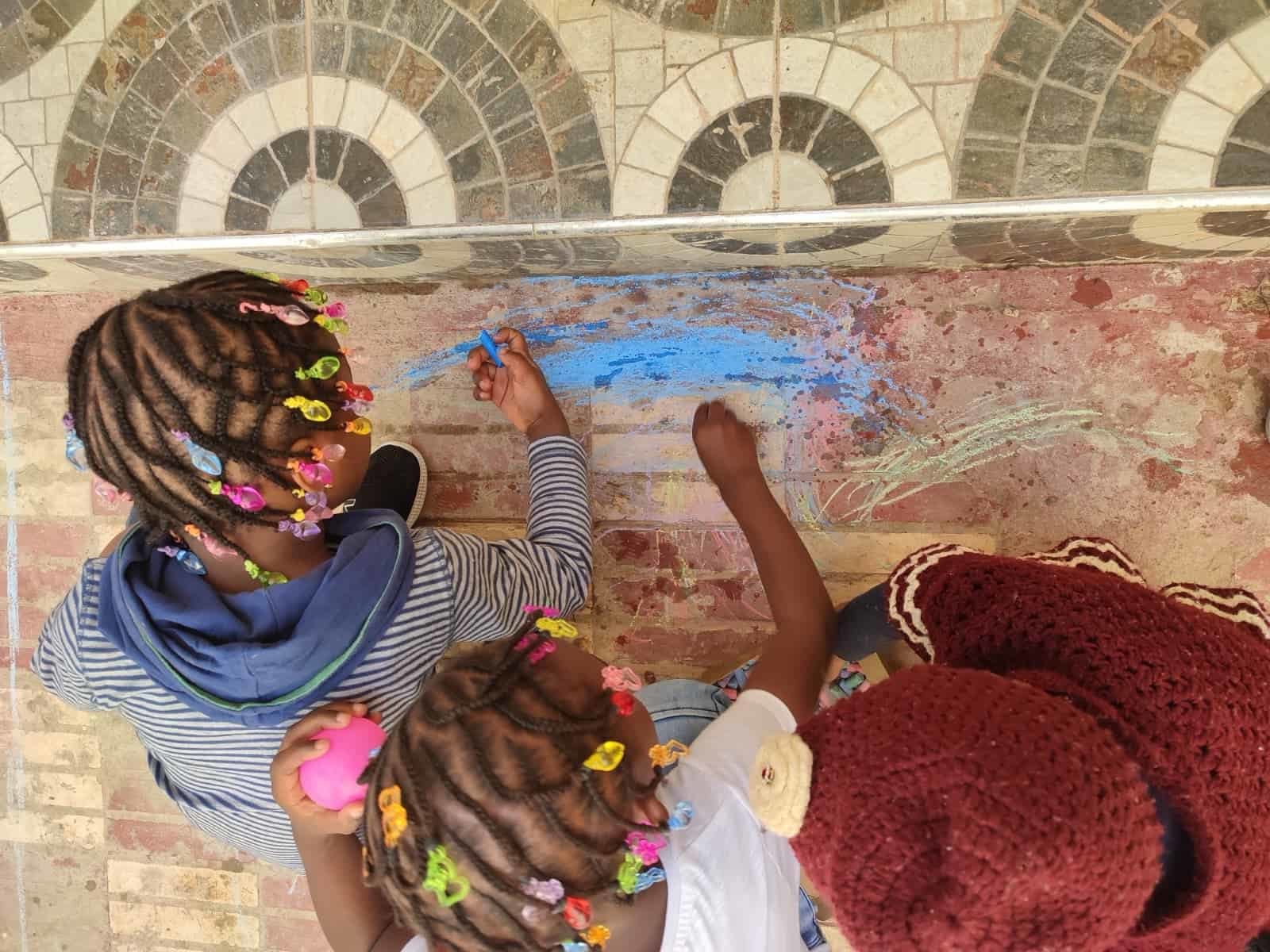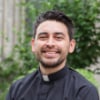Imagine the following scene:
On a Thursday morning around 10:00 am, a steel blue Nissan Terrano 4×4 parks in front of a small gray gate. Inside the car you can see me and my five friends. We are six Sub-Saharan African children 5 and 6 years old crammed in the car with two young women, Blanca, Marta, and the driver, Samir. The car has on its sides a sticker-sign with the four birds flying over a body of water, about to cross a white vertical line; the design reads the words: “delegacion de migraciones” and at the bottom “zona nador.”
The three adults, Blanca, Marta and Samir, help us out of the car and accompany us through the gate and enter a small open space where a lot of activity is taking place. As we walk in, there are three different directions we can take.
To the right you see a big wooden door that leads inside a big bright yellow building that you can see from blocks away. I always feel excited when I see it because I know I will be playing with my friends there. To the left you see a small door that leads to a garage, and last time I peeked in, I saw sub-Saharan men having breakfast and maybe getting ready for a class.
As you look forward, there is another set of wooden doors with the same sign as that on the sides of the car. There are men and women walking in and out to welcome people. I know many of them because they always say hi to me and I remember how happy my mom was when she received a food basket from one of them. I feel very happy when one of them plays with me when I arrive and starts chasing after me without being able to catch me.
In the open space, there are many women that look like my mom talking to each other and my eyes are immediately drawn to their beautiful dresses with weird designs in bright oranges, greens, blues and other earthy colors. Some of the women are sitting on a step near the wooden doors of the big bright yellow building; while others sit on benches. Some of them are carrying their babies on their backs while their older children play. My friends and I immediately join the fun and run around as we chase each other. I feel happy and safe here.
Ten minutes after our arrival, Blanca and Marta ask us to line up and get ready for today’s class. We enter the big bright yellow building and pass through the main hall where there are a lot of benches and on the walls there are statues of people that I have never seen before. The inside of that big building always makes me and my friends go “wow.” We carefully pass by a table that has a white cloth, two candles and a big book. Then, we enter a small room that connects to a house where people rest. But, here we have to pass through a hallway very quietly because there are women and babies sleeping in their rooms. Finally, we make it to the back garden of the house where we find our other teacher, Maria, waiting for us in our classroom.
The first thing we do is to have a small breakfast. I love sitting at the head of the table because I get to see everyone when we eat our delicious yellow apples. After breakfast we all help with cleanup where each one has a task to complete and play the game called “Bonjour” to practice routines, recognize the names of our friends and learn the days of the week. Then we are given free time to play games before doing the main activity of the day. Sometimes the smaller children use the small swimming pool when it is hot. Other times we do creative activities like painting, building with legos, playing with sand and shells; or learn mathematics and our letters. Every time I am doing all of these things with my friends I feel really good inside and can’t wait to return.
Today was very special because it was my turn to help lead the game named “Bonjour”. As Marta plays the Ukulele we sing and dance. Suddenly, I looked up and saw a tall man smiling down at me who began to greet everyone. I think his name was Danilo.
—
This is the scene I witnessed on September 1, 2022, my first day at the Diocesan Delegation of Migrations of the Diocese of Tanger, region of Nador, Morocco. The office and attention space of the Delegation is located in the old rectory of Santiago el Mayor Catholic Church, built in the early 20th Century by the Franciscans until it was turned over to the Jesuits in 2016. The Delegation provides “assistance and protection of vulnerable migrants throughout the northern Mediterranean coast of Morocco” and aims to facilitate migrant persons access to quality basic services. The interventions offered are: A Women’s Space, Medical Service, Social Service, Psychosocial Service and Shelter for the most vulnerable migrant people. This last place is where the children have arrived.
When I imagined my assignment at this border city, I knew about the many interventions for the adult migrant people, but I was not aware that I was going to see a well structured program for the attention and education of migrant children. The program showed me the holistic approach being used to serve the migrant population in this region, and at the same time I was moved with a deep sense of hope. A hope that emerged from the deepest part of my heart as I witnessed these migrant children being what they are, children; with the desire to play, learn, to be cared for, to be recognized.
Given its geographic location, Morocco is a country of emigration, immigration and is also an important part of the African migratory corridor towards Europe. The many migrant people that arrive at this border city, come from the Sub-Saharan region of West Africa (Guinea Conakry, Ivory Coast, Mali, Burkina Faso and Senegal) with the hope of making it to Europe, through Spain. These migrant people have left their countries of origin due to health, welfare, lack of protection, war, persecution, etc. As they move, they find themselves in an irregular administrative situation in transit and receiving countries.
Among the migrant people that arrive in Nador, Morocco, you find families and many are women that are alone with their children, living together in the margins of the city; like the mothers of the six children in the first scene. Others, particularly men, live in irregular settlements near the city where they not only lack security but also have to face the changing weather and harsh terrains. Since all these migrant people are in irregular situations their security is never guaranteed, which makes them a very vulnerable population.
The situation of vulnerability is aggravated for the migrant children. Though the Moroccan government has done a lot to provide education and health services for the migrant children, language barriers prevent regular uptake. On another level, the migrant families have an ongoing fear for their safety, and often prefer not to seek such services in order not to risk their stay in the city. The children find themselves living in precarious conditions where their physical and mental development is in jeopardy from very early on in their lives.
Blanca, Marta, Maria, Samir and every member of the Delegation, have responded to the church’s insistence to the care and accompaniment of migrant children when they started the program for the attention and education of migrant children amidst the pandemic in October of 2021. This program centers the needs and voices of migrant children revealing a lot still to be done. As I talked to all the people in the Delegation involved in the program, I was able to feel, hear and see their deep sense of care for these migrant children and the desire to give them a voice and provide to them a space where they are treated with dignity. This is a program that has helped an entire team provide a space where children can grow as agents of their own futures.
The more I understood the impact of the program on the migrant children and their families, the more the hope grew in my heart. I could see that these migrant children are developing their own sense of hope and trust in others. I also felt hope in a team that has taken the time to care for a very vulnerable population within a vulnerable population. I felt consolation on seeing how these migrant children were being given:
a sense of stability when everything around them is unstable;
a sense of security when security is what they lacked;
a space to be cared for when often they are faced with uncertainties;
a space to play and learn, when their parents may not have the resources to provide them these basic needs.
The last time I visited the children’s space, I stayed to be part of the activities led by the new volunteer, Hannah. As they were having breakfast, I sat in one of their little chairs and when they saw that I looked like a giant sitting in their chairs, we all started to laugh uncontrollably. We sang and danced to the song “Bonjour”. After playing a little bit I told them I needed to go to a meeting. At that moment a four year old boy held my arm and said “arrête, reste ici avec nous” (stop, stay with us), the other children started to shout, “stay, stay, stay.” At that moment my heart shrunk as I looked him in the eyes and could see the whole future in his eyes. As I stood up, he held onto my leg. I told him that I would return and play with everyone. Then, he let go of my leg and continued to follow the instructions that Hannah was giving them. I walked towards the office feeling my heart shrunken in complete tenderness while the look in his eyes rested in my heart.
-//-
Thank you to all the members of the Delegation and volunteers who provided photos and information about the beginnings of this program. In particular to the volunteers Blanca, Martha who helped start it and Maria who provided the photos. But above all, thank you to all the children, the bearers of hope.


